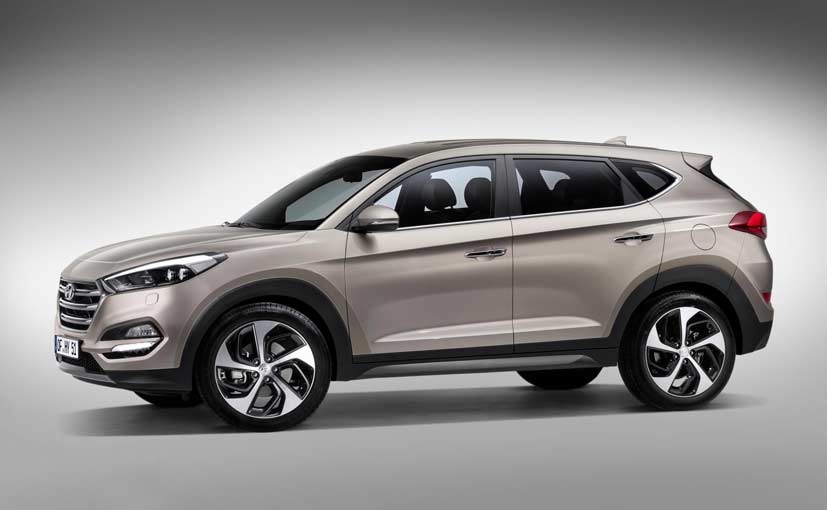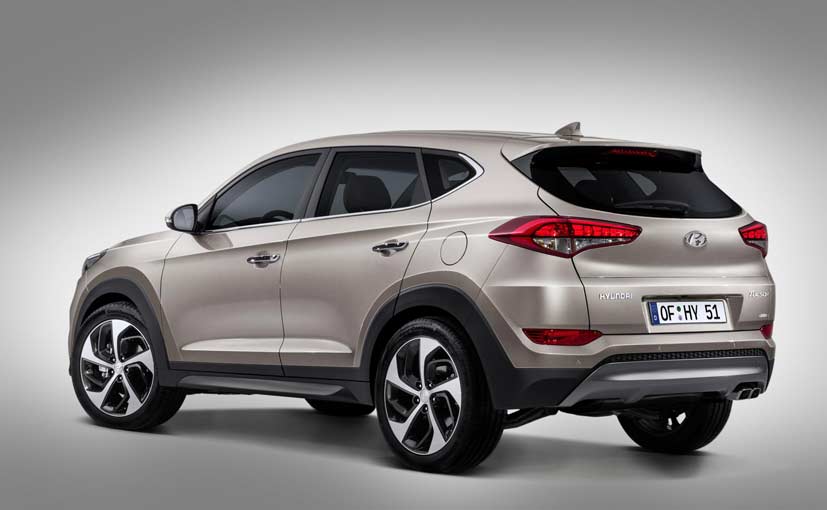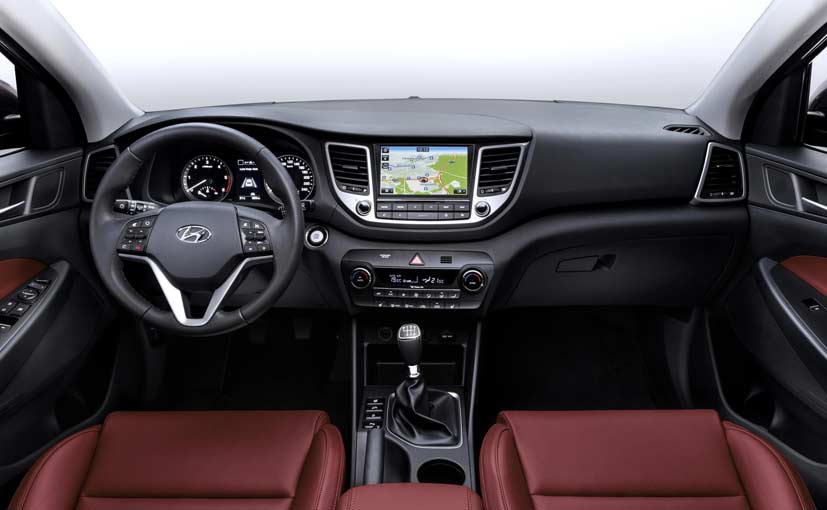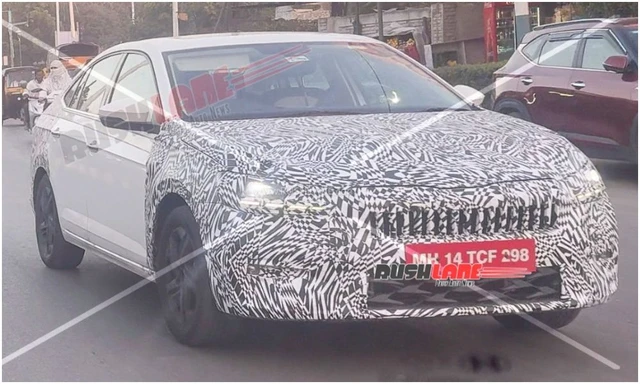Hyundai Tucson to Make Indian Comeback?

The Tucson was initially launched in India in 2005 but was discontinued soon after due to a lack in demand. In terms of design, the new-look, 3rd generation Tucson is far better to look at than its predecessor. The fluid-inspired lines and curves that run along its body-shell, paired with its aggressive front end gives the Tucson a sporty yet butch look.

The front fascia features a large trapezoidal grille up front with 3 chrome-lined slats, a pair of slender swept-back head-lamps and stylish two-part fog-lamp units which are integrated into angular enclosures in the heavily sculpted bumper. From the side, the relatively narrow chrome-lined glass house tapers upwards from the A pillar which makes for a sleek and aesthetically aerodynamic look. This is further highlighted by the prominent side-line that begins from the front wheel arch and runs across the side of car, parallel to the window line, before disappearing into the wrap-around section of the high mounted tail-lamp unit. The wheel arches themselves are uniquely designed and appear to lean forward. This and the dipping roofline further accentuate the new Tucsons's coupe-esque stance.

The rear of the vehicle features a pair of narrow, horizontally mounted tail-lamp clusters which are reminiscent of the units found on other current generation Hyundai vehicles. In fact, the combination of a low-lying rear roof-line with a spoiler, smallish rear windscreen, tailgate mounted number plate, and overall curvy design language makes the new Tucson look remarkably similar to the Hyundai Santa Fe and i20 Active both of which are also based on the aforementioned FS 2.0 design platform.
The interiors aren't exquisite to look at but appear neat and functional. The new Tucson comes equipped with an 8-inch touchscreen infotainment unit, soft touch plastics, an electronically operated Smart Tailgate, Electronic Parking Brake (EPB), a panoramic sunroof, automatic parking, and a driving mode selector. On the safety front, the Tucson has been packed with 6 airbags, Autonomous Emergency Braking (AEB), Blind Spot Detection (BSD) technology, Static Cornering Lights (SCL), and Lane Departure Warning System with Lane Keep Assist (LKAS).

Internationally, the new Tucson is offered with a range of petrol and diesel engines although it's likely that if it were to come to India, the entire range of engines may not be on offer as it will probably be imported as a completely built unit (CBU). Given the mileage benefits of diesel engines, the India-spec Tucson is likely to feature one of the available variants of Hyundai's 2.0-litre CRDi powerbox. The more powerful version makes 182.5bhp and 402Nm of torque whereas the more environmentally friendly Blue Drive variant of the same engine makes 135bhp and 373Nm to keep mileage figures high. An even more efficient 1.7-litre CRDi Blue Drive unit is also available in foreign markets, which is good for 114bhp and 280Nm of torque. Currently, the diesel range is offered with a choice of either a 6-speed autobox or a 6-speed manual transmission in both AWD and FWD configurations. A dual-clutch gearbox is also offered but only on certain petrol variants.
If the new Tucson were to arrive on Indian shores, it would compete against the likes of other premium compact SUVs like the Honda CR-V. Pricing can be expected to fall in the sub-Rs 25 lakh category as it will be placed between the Hyundai Creta and Santa Fe SUVs.
Trending News
Latest News
 car&bike Team | Dec 13, 2025Skoda Slavia Facelift Spied Testing Again Ahead Of DebutThe facelifted Slavia is expected to debut in 2026 as Skoda-VW India looks to refresh its India 2.0 range.1 min read
car&bike Team | Dec 13, 2025Skoda Slavia Facelift Spied Testing Again Ahead Of DebutThe facelifted Slavia is expected to debut in 2026 as Skoda-VW India looks to refresh its India 2.0 range.1 min read car&bike Team | Dec 13, 20252026 MG Hector Facelift Interior Previewed Ahead Of DebutLatest teaser video of the upcoming Hector facelift suggests minimal cosmetic changes to the interior as well as reveals a new alloy-wheel design.1 min read
car&bike Team | Dec 13, 20252026 MG Hector Facelift Interior Previewed Ahead Of DebutLatest teaser video of the upcoming Hector facelift suggests minimal cosmetic changes to the interior as well as reveals a new alloy-wheel design.1 min read Jaiveer Mehra | Dec 13, 2025Passenger Vehicle, Two-Wheeler Sales Surge In November 2025: SIAMBoth segments reported a growth in the region of 20 per cent, though year-to-date sales growth in FY2026 was notably flatter at around 3 per cent.1 min read
Jaiveer Mehra | Dec 13, 2025Passenger Vehicle, Two-Wheeler Sales Surge In November 2025: SIAMBoth segments reported a growth in the region of 20 per cent, though year-to-date sales growth in FY2026 was notably flatter at around 3 per cent.1 min read car&bike Team | Dec 12, 2025Nissan Entry MPV Design To Be Unveiled On December 18New MPV to be the first of three new models for India by Nissan, alongside the Tekton and a three-row SUV.1 min read
car&bike Team | Dec 12, 2025Nissan Entry MPV Design To Be Unveiled On December 18New MPV to be the first of three new models for India by Nissan, alongside the Tekton and a three-row SUV.1 min read Jaiveer Mehra | Dec 12, 2025New Mini Convertible Launched At Rs 58.50 LakhDrop-top variant of the iconic Cooper hatchback available in a single Cooper S spec.1 min read
Jaiveer Mehra | Dec 12, 2025New Mini Convertible Launched At Rs 58.50 LakhDrop-top variant of the iconic Cooper hatchback available in a single Cooper S spec.1 min read car&bike Team | Dec 12, 2025Mahindra XUV 7XO Pre-Bookings Open December 15The mid-cycle update to the XUV 700, the XUV 7XO, is set to borrow design elements and tech from the new Mahindra XEV 9S.2 mins read
car&bike Team | Dec 12, 2025Mahindra XUV 7XO Pre-Bookings Open December 15The mid-cycle update to the XUV 700, the XUV 7XO, is set to borrow design elements and tech from the new Mahindra XEV 9S.2 mins read
 Janak Sorap | Dec 11, 2025Harley-Davidson X440 T First Ride Review: Smarter and SharperHarley-Davidson has taken the X440 and given it a more focused and engaging twist. The result is the X440 T—essentially the same platform but updated in areas that give the motorcycle more appeal and riders more thrill.5 mins read
Janak Sorap | Dec 11, 2025Harley-Davidson X440 T First Ride Review: Smarter and SharperHarley-Davidson has taken the X440 and given it a more focused and engaging twist. The result is the X440 T—essentially the same platform but updated in areas that give the motorcycle more appeal and riders more thrill.5 mins read Shams Raza Naqvi | Dec 10, 20252025 Mini Cooper Convertible Review: More Colour On Indian RoadsThe updated Mini Cooper Convertible is set to be launched in the Indian market in the next few days. We drive it around Jaisalmer for a quick review.1 min read
Shams Raza Naqvi | Dec 10, 20252025 Mini Cooper Convertible Review: More Colour On Indian RoadsThe updated Mini Cooper Convertible is set to be launched in the Indian market in the next few days. We drive it around Jaisalmer for a quick review.1 min read Bilal Firfiray | Dec 8, 2025Tata Sierra Review: India’s New Favourite?Marking its return after a few decades, the reborn Sierra has made everyone sit up and take notice. But is it worth the hype?10 mins read
Bilal Firfiray | Dec 8, 2025Tata Sierra Review: India’s New Favourite?Marking its return after a few decades, the reborn Sierra has made everyone sit up and take notice. But is it worth the hype?10 mins read Girish Karkera | Dec 4, 20252026 Honda Prelude First Drive: Domesticated Civic Type RA sporty-looking coupe built to give customers a taste of performance but not at the expense of everyday practicality.5 mins read
Girish Karkera | Dec 4, 20252026 Honda Prelude First Drive: Domesticated Civic Type RA sporty-looking coupe built to give customers a taste of performance but not at the expense of everyday practicality.5 mins read Seshan Vijayraghvan | Nov 29, 2025Mahindra XEV 9S First Drive Review: Big Electric SUV, Bigger ExpectationsThe XEV 9S lands at a time when the EV crowd is growing fast. It’s a big, born-electric, three-row SUV that starts under 20 lakh. It sits close to the XUV700 in size, but the brief is very different. Here’s what it’s like on the road.11 mins read
Seshan Vijayraghvan | Nov 29, 2025Mahindra XEV 9S First Drive Review: Big Electric SUV, Bigger ExpectationsThe XEV 9S lands at a time when the EV crowd is growing fast. It’s a big, born-electric, three-row SUV that starts under 20 lakh. It sits close to the XUV700 in size, but the brief is very different. Here’s what it’s like on the road.11 mins read














































































































































